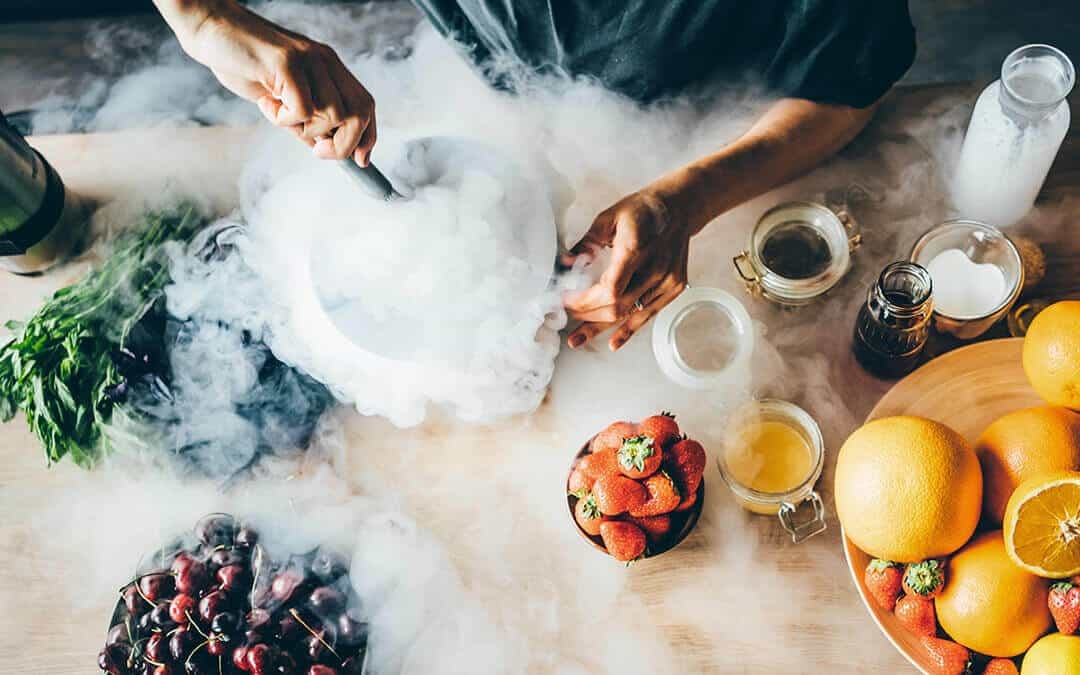Liquid nitrogen has become a popular tool in the culinary world, creating exciting and visually appealing frozen desserts and snacks. You’ve likely seen these creations at shopping malls, amusement parks, fairs, and restaurants. This guide will explore the uses of liquid nitrogen in food, safety considerations, and, most importantly, where to buy liquid nitrogen for food safely and reliably.
Liquid Nitrogen in Food: The Appeal
The extremely low boiling point of liquid nitrogen (-196°C or -320°F) allows it to freeze foods rapidly, resulting in unique textures and consistencies. This rapid freezing also creates a dramatic vapor effect, famously used in “dragon’s breath” snacks. Dragon’s breath, also known as heaven’s breath, utilizes ice creams, cereal treats, cheese puffs, and drinks to create the effect of smoke billowing from the mouth after consumption.
Safety Considerations When Using Food Grade Liquid Nitrogen
While the vapor effect and the foods prepared with liquid nitrogen are inherently safe when handled correctly, improper use can lead to serious injuries. Accidental ingestion or mishandling of liquid nitrogen can cause burns, frostbite, bowel perforation, or asphyxiation due to the extreme cold.
Recognizing these risks, the FDA has issued a warning against ingesting foods prepared with liquid nitrogen at the point of sale. It’s crucial that food handlers follow recommended guidelines and consumers wait a sufficient amount of time for the liquid nitrogen to fully evaporate before consumption.
FDA Safety Recommendations for Food-Grade Liquid Nitrogen
To ensure the safe use of liquid nitrogen in food preparation, the FDA recommends the following:
- Use only food-grade nitrogen: This ensures the nitrogen is free from contaminants.
- Ensure no residual liquid nitrogen remains: The serving container should be free of any liquid before serving. Refills of liquid nitrogen to the consumer should be prohibited.
- Use a narrow-opening container: This prevents consumers from accidentally pouring liquid nitrogen onto themselves.
- Handle with utensils: Always use a utensil to pick up items prepared with liquid nitrogen, never bare hands.
- Provide clear instructions: Inform consumers about the dangers of liquid nitrogen and the necessary precautions.
Accidental contact with liquid nitrogen can cause burns or frostbite, while inhalation or ingestion can lead to asphyxiation and gastric or airway perforations. Numerous incidents of injuries and trauma have been reported due to improper handling of liquid nitrogen.
Examples include chemical burns from handling liquid nitrogen desserts and stomach perforations requiring surgical removal of parts of the stomach after ingesting liquid nitrogen. Other potential problems include rapid abdominal pain, distension, and respiratory distress, particularly in individuals with asthma.
How to Buy Liquid Nitrogen for Food Safely
It is extremely important to allow time for any residual liquid nitrogen to evaporate before ingesting. Otherwise, you risk injuries or burns. Some frozen confections are prepared in such a way that the liquid nitrogen is completely evaporated by the time it reaches the customer.
Where to Buy Liquid Nitrogen for Food
When considering where to buy liquid nitrogen for food, it’s essential to prioritize suppliers that offer food-grade nitrogen and adhere to strict safety standards. Here are some options:
- Local Gas Suppliers: Many local gas suppliers specialize in industrial and medical gases, including liquid nitrogen. Look for suppliers that explicitly offer food-grade liquid nitrogen and can provide documentation of purity and safety.
- Welding Supply Stores: Some welding supply stores may carry liquid nitrogen, but it’s crucial to confirm that the product is food-grade.
- Online Retailers: While online retailers might offer liquid nitrogen, exercise caution and verify the supplier’s credibility and safety certifications.
- Specialty Chemical Suppliers: These suppliers often cater to research labs and may offer food-grade liquid nitrogen.
Key considerations when choosing a supplier:
- Food-Grade Certification: Ensure the liquid nitrogen is certified as food-grade and meets the required purity standards.
- Safety Documentation: Request safety data sheets (SDS) and handling guidelines.
- Delivery Options: Consider the supplier’s delivery capabilities and ensure they can safely transport liquid nitrogen to your location.
- Storage Solutions: Discuss storage options with the supplier to ensure you have a safe and compliant storage system.
- Training and Support: Check if the supplier offers training on the safe handling and use of liquid nitrogen.
Conclusion
Liquid nitrogen can add a unique and exciting element to food preparation, but safety should always be the top priority. By following FDA recommendations and choosing a reliable supplier of food-grade liquid nitrogen, you can minimize the risks associated with its use. Remember to allow sufficient time for evaporation before consumption and provide clear instructions to consumers. With proper precautions, you can safely enjoy the culinary possibilities of liquid nitrogen.
